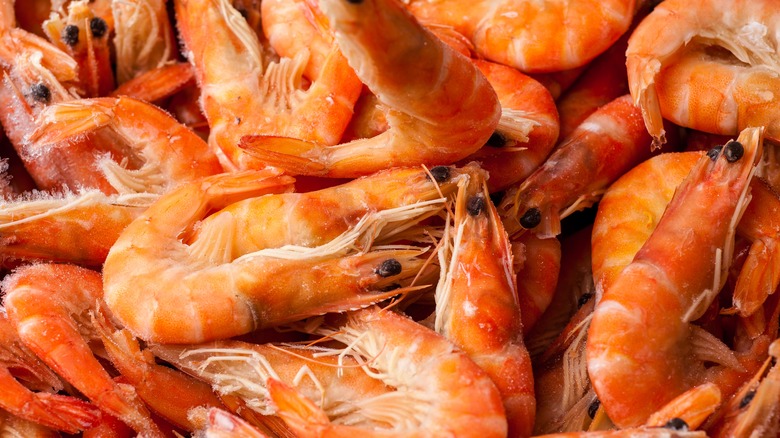What You Need To Know About Buying Shrimp With The Heads Attached
According to Sun Shrimp, Americans consume at least a billion pounds of shrimp each year. Shrimp are sold with or without heads, peeled or shell-on, fresh, refreshed, previously frozen, or frozen. 90% are imported. Buying crustaceans with heads attached is a different kettle of fish than purchasing ones that are no longer intact. There are significant differences in cost, weight, and how they are stored.
Shrimp with heads still on have the edge in flavor. However, they require more work to prepare, take up more space, and according to Alabama A & M and Auburn Universities Extension, are more likely to spoil. The shrimp heads themselves have unique uses and provide extra nutritional value. But they can also contain up to 80% of a specimen's bacteria, asserts the NIH National Library of Medicine. The head is vulnerable to spoilage, and shrimp with them need to be impeccably stored.
Whether this body part is considered a delicacy varies from culture to culture. Headed shrimp can be found in many Asian restaurants and sushi bars but not in typical grocery stores or restaurants. According to Nation's Restaurant News, a recent 119% uptick in distributors' shrimp shipments, including the heads, is proof of growing acceptance in the U.S.
purchasing and storing shrimp with heads
Buying shrimp with heads attached is economical. A Geek Outside calculates that decapitated shrimp selling for $5 per pound would cost $2 more than those with heads still on. Head-off shrimp also weighs 35% less. Louisiana Direct Seafood estimates that a 16/20 count (meaning 16-20 shrimp per pound) for head-on shrimp becomes 26/30 when that part is excluded.
Eating Expired states that a shrimp can be frozen for six months and retain its flavor. The National Center for Home Food Preservation recommends freezing shrimp with shells but no head for optimum quality and length of storage.
According to Eating Expired, most of a shrimp's fat is located in the head and will spoil first. The base of a shrimp's head contains a gland called the hepatopancreas. It begins to release enzymes when the creature dies, breaking down the flesh and making it mushy — removing the heads before shipping tends to result in a fresher-tasting, crunchier product. The Food Untold suggests purchasing headless shrimp unless you can verify it is fresh and comes from a shrimp farm.
cooking with head on and eating it with pleasure
A shrimp's flavor and juiciness are enhanced by maintaining the briny head. Retaining only the shell for cooking also works. Cooking with the head still on boosts the taste, but the shrimp will be peskier to peel than one without. Removing a shrimp's head before cooking requires care to avoid getting pierced. Crawfish Cafe recommends placing a colander in the sink and having plenty of paper towels on hand. Carefully twist the head behind the gills and excise the black digestive organ. Remove the two antennae as well.
Grilled shrimp with heads is a popular way to serve it, and the heads themselves are a treat when fried. Slurping the juice from the head is an alternative to eating it whole, although the liquid is considered bitter by some. Shrimp heads that are removed can be frozen and reserved for stock. Ruth Reichl touts the deep red broth derived from the heads and suggests using the shrimp stock in paella, pasta dishes, or seafood bisques. The discarded shrimp heads are even suitable for use in the garden for composting.


